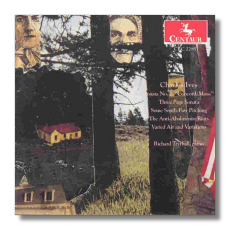
The Internet's Premier Classical Music Source
Related Links
- Ives Reviews
- Latest Reviews
- More Reviews
-
By Composer
-
Collections
DVD & Blu-ray
Books
Concert Reviews
Articles/Interviews
Software
Audio
Search Amazon
Recommended Links
Site News
 CD Review
CD Review
Charles Ives

"Concord" Sonata
- Second Piano Sonata "Concord, Mass., 1840-60"
- Three-Page Sonata
- Studies
- #9 "The Anti-abolitionist Riots"
- #21 "Some Southpaw Pitching"
- Varied Air and Variations
Richard Trythall, piano
Lauren Weiss, flute
Centaur 2285 - 74min
Trythall, a very fine pianist, understands Ives and the foundation of the music both in improvisation and in thematic "iconography." Ives obsessively wove in "Columbia, the Gem of the Ocean," Beethoven's "fate knocking at the door" from the fifth symphony, the ragtime song "Hello! Ma Baby," and several hymns and revival songs throughout more than one piece. Furthermore, Ives' use is seldom purely musical, just as Warhol's Marilyns and Elvi are not merely color and form.
The problems that meet me in Trythall's accounts have less to do with intrinsic merit, more with comparing him to the astonishing readings by Daan Vandewalle (Rene Gailly 87078), reviewed in the previous issue. Without violating the basic nature of Ives' music, Vandewalle gives the listener a musical thread to follow through an entire movement. Trythall tends to keep the "fits and starts" nature characteristic of improvisation. It seems to me that Vandewalle has mined the "Concord" Sonata much more deeply and successfully, in the "Emerson,""Hawthorne," and "Thoreau" movements. However, Trythall reaches his interpretive peak in "The Alcotts," which is simply the best recording of this movement I know. The relatively simple and even sentimental materials challenge the interpreter to find a way of playing that doesn't condescend. Trythall transcends this negative and turns the movement into poetry. The sentimental remains, but as Ives viewed it - the earthly reflection, "through a glass, darkly," of cosmic truth, which Ives (but not me) could capitalize without irony. Nevertheless, if I had to choose, I'd pick Vandewalle over Trythall unhesitatingly.
I've never seen the point of "The Anti-Abolitionist Riots," which remains for me a study for larger things, like the "Concord" Sonata. Trythall here joins a long list of pianists (including Vandewalle) who fail to change my mind. On the other hand, the "Three Page Sonata" is a concise gem - Ives in little, but still potent. Trythall does wonderful things with it, not least of which is his keeping the textures clear, not always easy due to the composer's penchant for throwing in "yet another thing" that's just occurred to him. Trythall's softly tolling Adagio movement rolls out like bells in a fog, with a clear chime penetrating now and then - lovely.
"Some Southpaw Pitching" and the "Varied Air" are mainly Ives having fun. "Southpaw" provides a workout, appropriately enough, for the left hand. I particularly like Trythall's handling of the "fife and drum" quote toward the end, emphasizing the link to a similar moment in the finale of the second symphony. "Varied Air" has a program: a pianist trying to appease an audience of musical "mollycoddles." Each variation up to the penultimate is followed by a murmuring, tone-cluster "protest" from the attendees. Ives then throws in a "church organist" variation, which irons out the rough edges. The audience applauds in pure major, whereupon the pianist gives the wildest "wild man" variation yet, to have the last word. To me, Ives may work against his own intent. I like very much the "church organist" variation, beautiful in the way of the incipit to his second symphony. Trythall, wisely in my opinion, resists the urge to ham it up.
Recorded sound is quite good, presenting the sonic image of a good room, rather than a hall or studio. Piano highs are bright without shrillness and the bass tells.
Copyright © 1996, Steve Schwartz


















